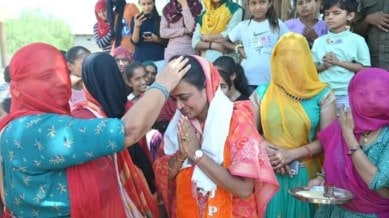Stay updated with the latest - Click here to follow us on Instagram
Hurdle before EC in Banaskantha — ensuring women vote
In Valsad, while 75.86 per cent of the men voted in the 2019 Lok Sabha elections, the figure for women was 74.56 per cent.

In Banaskantha, the only district where the Lok Sabha candidates of both BJP and Congress are women, the Election Commission (EC) has a tough task – to motivate women to come out to vote on May 7.
Women from most communities in the district still follow the old age tradition of wearing ghunghat in front of the male members of the house and come out to vote only if accompanied by one of them.
monthly limit of free stories.
with an Express account.
At Lavana village in Lakhani taluka, Parvati Rajput (25), a graduate who has been married for eight years, treads cautiously to fetch water for cooking from a handpump located in the open verandah of the house built in bajri farms. With a veil extending till her waist, she ensures not to step out while her father-in-law is in sight.
“This is the tradition we have been following since generations. Even my mother-in-law wears a long veil before her husband, when our grandmother is in the house,” she says while kneading bajri flour with her four-year-old daughter in her lap. Parvati’s husband Mahendra adds, “Women of our house do go out to vote but only if accompanied by men from the family.”
In the 2022 Gujarat polls, the only district in the state that saw a higher turnout of women than men was Dang, where 67.88 per cent of the over 96,000 women voters turned out to vote. Among over 97,000 male voters, 66.7 per cent voted. Banaskantha district, meanwhile, saw 69.29 per cent of its 11.98 lakh women electors voting – considered a lower number among rural districts.
With Gujarat set to vote on May 7, most women in Banaskantha are still not aware of their candidates, but can identify national leaders like Prime Minister Narendra Modi and Congress MP Rahul Gandhi.
Satiben Rajput (37) from Khimanavas village in Vav says, “We do vote but whom to vote for is decided by the male head of the household. The villagers and male family members ensure that the women first cast their vote to avoid any inconvenience.”
When contacted, Banaskantha collector Varunkumar Jagdish Baranwal says, “We are aware of the situation. Looking at this, we are specially focussing on women voters. Self-help groups, anganwadi workers, female cooperative workers have been mobilised for the purpose.”
The administration, however, has failed to rope in female social media influencers to woo women voters. “Unfortunately, only one female social media influencer, a radio jockey from Palanpur, could be roped in,” the collector says.
Congress candidate Geniben Thakor has also been stressing on participation of women in her campaign. “The mothers and sisters of the village should come out to help their Banas ni ben Geniben (Banas’ sister Geniben) and vote. Make it a point to vote when you go in the morning to the village dairy. Perform both the tasks together on May 7,” she appeals to women voters in Velavada village in tribal belt of Danta while campaigning. She faces BJP’s Rekhaben Chaudhary on May 7.
Banaskantha has nearly 95,000 more male voters than women. In the 2022 state polls, with 565 polling stations, Banaskantha had bagged the third spot in the state when it came to witnessing a gap of over 10 per cent between men and women who turned out to vote. It was the only rural district after urban centres Ahmedabad and Rajkot that had recorded the highest number of polling stations that witnessed a male-female voting gap of more than 10 per cent.
Further, while the 2019 Lok Sabha poll data shows a wide gap between male and female turnout in Kshatriya-dominated constituencies, turnout of tribal women had been as high numbers as their male counterparts.
For instance, in the Lok Sabha constituencies with a high number of Kshatriya voters, including Bhavnagar where there are estimated 3 lakh Kshatriya voters, 54.84 per cent women voted – nearly 7 per cent lower than the men and more than 4 per cent lower than overall turnout on the seat.
Similarly, in Sabarkantha, which has an estimated 2.25 lakh Kshatriya voters, the gap between male and female turnout was 6 per cent. Banaskantha, with an estimated 1.5 lakh voters from the community, the gap was almost 10 per cent – female turnout recorded at 59.82 per cent against 69.08 per cent for males.
However, in the tribal areas with reserved Lok Sabha constituencies of Dahod, Chhota Udepur, Bardoli and Valsad, the highest gap recorded was 5
per cent.
In Valsad, while 75.86 per cent of the men voted in the 2019 Lok Sabha elections, the figure for women was 74.56 per cent. Bardoli recorded a male turnout of 75.58 per cent, the figure for women was 71.48 per cent. While in Chhota Udepur, 75.77 per cent men and 70.96 per cent women voted, Dahod, 67.65 per cent men voted against 64.7 per cent of women.